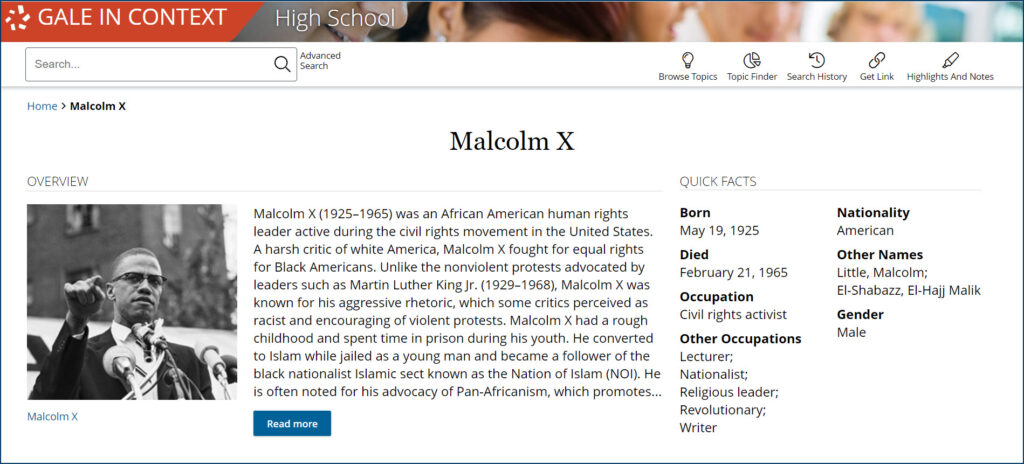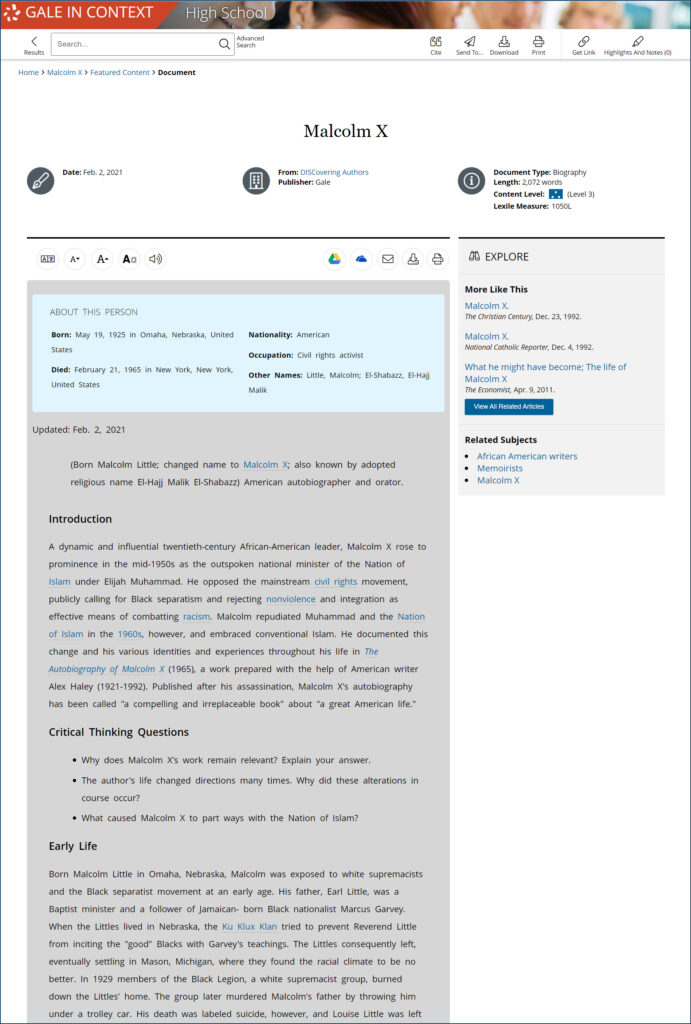| By Gale Staff |
Understanding Malcolm X is vital today. His story remains powerful yet polarizing. The assassination of Malcolm X in 1965 extinguished a pivotal voice in the civil rights movement. We need to understand Malcolm X today because he captured the imagination and attention of millions tired of waiting for incremental change.
He walked a complex road, from street hustler to influential leader. His views shifted and expanded over time, alongside America’s own struggle for justice and equality.
An educator’s job—and sometimes greatest challenge—is answering the question: how do we bring this pivotal figure to life? The answer is simple.
Bringing historical figures and the time they lived in can be a challenge for educators. Gale has your back. Through our specially curated content for the high school classroom, you can access the primary sources below to create a gateway into the era in which Malcolm X lived:
- Speeches
- Interviews
- Biographies
- Writings
- Footage
- Photographs
Gale In Context: High School offers a wealth of such documents, perfect for immersing students in Malcolm X and the broader civil rights movement.
Let’s explore how to leverage these materials to bring the life and times of Malcolm X into focus for your students.

A Brief Biography of Malcolm X
Malcolm Little’s childhood was marked by pain and adversity. Evidence suggests that white supremacists murdered his father. His mother was institutionalized. Malcolm lived in foster care and detention homes. Bright yet rebellious, he turned to criminal activities leading to a 10-year prison sentence in 1946.
In jail, Malcolm educated himself and converted to the Nation of Islam, a movement combining elements of Islam with black nationalism. During his time in prison, Malcolm became a devoted member. After his release, he took on a role as a minister and quickly rose to become a national spokesman.
Biographies, interviews, and speeches are easily searchable by Lexile range within Gale In Context: High School profile Malcolm’s transformation. Students can examine first-hand accounts to understand his anger toward injustice and his initial controversial ideas on segregation. When students have exposure to diverse original documents, it provides nuance and builds empathy for experiences fueling Malcolm’s journey.
Learning About and Teaching Malcolm X’s Early Life
Gale In Context: High School offers a profile of Malcolm X’s challenging upbringing and conversion to the Nation of Islam while in prison. Students can examine news articles, magazines, primary sources, and much more detailing:
- The murder of his father by white supremacists and the trauma of foster care and detention homes as a child
- Teenage involvement in criminal activity, which led to a 10-year prison sentence
- His self-education and adoption of the Nation of Islam’s teachings in jail
Exposing learners to original materials from varied perspectives provides a nuanced window into this formative period.
Examining Malcolm X’s Activism and View Evolution
As Malcolm X’s visibility grew, so did tensions. His uncompromising critiques of white society and mainstream civil rights leaders proved polarizing. But, his philosophy evolved upon leaving the Nation of Islam in 1964.
As students explore Malcolm X’s increasingly prominent activism and speeches with the Nation of Islam, they can examine how his rhetoric and outlook evolved over time. Materials in Gale In Context enable analysis of these pivots and debates around his contested legacy.
Gale In Context: High School includes:
- Transcripts and footage of speeches espousing black self-reliance and critiquing non-violent civil rights efforts
- News headlines demonstrating Malcolm X’s rising national visibility
- Magazine profiles from the early 1960s highlight controversies and concerns about his rhetoric
Comparing earlier forceful speeches with Dr. Martin Luther King’s calls for peaceful protest sparks fruitful discussion. Rhetorical analysis activities help students evaluate messaging and persuasive techniques on different sides. Seeing Malcolm X’s stances moderating after leaving the Nation provides insights into his changing philosophy.
Evaluating Malcolm X’s Contested Legacy
Materials in Gale In Context: High School enables analysis of Malcolm X’s departure from the Nation and subsequent assassination in 1965. FBI file records offer a window into the distrust and fear he elicited from authorities as his views broadened. Contrasting eulogies praising him as a courageous leader committed to human rights versus those condemning his divisive rhetoric provide a basis for students to debate and develop informed perspectives on his complex legacy.
By delving into the array of primary documents from Gale’s archives, learners can thoughtfully construct their own conclusions. Rather than receiving a simplified narrative, they gain skills in interpreting evidence, contextualizing historic moments, and evaluating diverse perspectives.

Promoting Critical Inquiry through Primary Sources
At its core, history should spark curiosity in each of us to thoroughly investigate the past so that we can better understand the present. As a high school teacher, you do just that every day. We’re here to help. The thousands of documents and media within Gale In Context: High School illuminate not just Malcolm X but the broader civil rights struggle unfolding across America.
Consider guiding questions to promote inquiry, analysis, and discussion:
- What different perspectives on Malcolm X emerge in the sources? How did other civil rights leaders like Dr. Martin Luther King, Jr. see Malcolm X?
- How did public views—and Malcolm X’s own views—shift over time?
- How did geographic, political, and religious affiliations influence opinions on civil rights efforts?
- How do leaders use rhetoric, symbols, and imagery to influence attitudes? How did Malcolm X’s approach differ from others like Martin Luther King?
Using Gale In Context: High School you can further engage students with activities like speech analysis, inviting students to enter historic debates and build critical thinking skills through reflective writing. Immersed in the original documents, students gain agency to construct their own understanding.
Empowering Deeper Understanding
Gale In Context: High School contains a wealth of documents and materials to illuminate Malcolm X’s story and the broader civil rights movement.
Let us help you leverage these rich primary sources to empower students with a deeper understanding of history and its lessons.
Request a demo of Gale In Context: High School with your local library or school district, or reach out to us! Our team is ready to help you integrate these resources into your civil rights curriculum.

